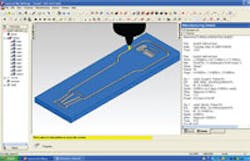Manufacturers are always searching for ways to lure a new generation of workers into their industries. Well, a new program in Hawaii has certainly uncovered a novel approach of presenting manufacturing to students.
The Invention Factory, a three-year study sponsored by the University of Hawaii at Manoa Curriculum Research & Development Group and funded in part by the National Science Foundation (NSF), seeks to stimulate interest in math and science by providing afterschool programs that thrust students into unusual activities.
One of those activities was training 48 students to design and build from scratch their own Hawaiian electrical steel guitars. Students were introduced to the project using Delcam’s FeatureCAM CNC programming software, which enabled each student to define the geometry and produce almost every part in the guitar.
One of the inherent challenges facing Hawaii is the lack of depth in the workforce. Local students often leave for the mainland once they graduate from school. As a result, beyond tourism and defense no third industry has been established in Hawaii.
In the Invention Factory and Makery’s first year, middle school students made assistive devices for disabled children, such as a toy that could be controlled by external switches. During the second year, students focused on building devices to assist older people.
“For the third year, we thought it was time to have them make something for themselves,” says Raemi Shibata, instructor for the program.
As part of designing and building the guitar, students learned physics (frequency, sound waves, vibrating strings, harmonics, electromagnetic generators, electronic amplifiers and loudspeakers), some basic music theory (musical intervals, scales, chords tempo and timing), some electrical circuitry (pickup, volume, tone and amplifier circuits), computer aided design (CAD), computer aided manufacturing (CAM), material selection, hand tools, computer controlled machines, assembly, painting and finishing.
According to Shibata, teaching students CNC programming was made far easier by separating the design and manufacturing functions between AutoDesk Inventor and FeatureCAM.
“Inventor enables our students to draw realistic objects in their first session with the software by creating sketches, dimensioning them and adding the third dimension,” says Neil Scott, Director of the Invention Factory and Makery. “FeatureCAM provides the ability to automatically recognize features such as holes, slots, pockets, and bosses in 3D solid and surface models. This means that students don’t have to deal with each individual surface but can program a much smaller number of features instead. FeatureCAM reads the native Inventor file format. We train the students to import the model and use feature recognition. The software automatically recognizes and organizes the features in the part. The students then review the list of features identified by the software and make any changes they wish such as merging, splitting, adding or deleting.”
After the student is satisfied with the list of features, the next step is assigning machining operations by picking tools and speeds and feeds for machining particular features. When making a typical part, there are often many features that are duplicated, and the machining operation only needs to be defined once. Students are encouraged to create libraries of features that can be re-used whenever one of them fits a new part. After finishing the program, students view a simulated version on the computer screen that they check to be sure the part is made exactly as intended and that the tools stay clear of the machine and fixtures.
Apart from a few purchased components, such as the tuning keys, pickups, electronic tuner, and strings, the 48 students in the program designed and built every part of the guitar. To save time, certain students were assigned to make some of the smaller parts in volume. The electronic tuner is integrated by replicating the enclosure of the tuner, including supports and holes, inside the guitar. The fret board was too long to be machined in a single setup on the tabletop mill, so one of the students designed and made a vacuum table that enables the fret board to be milled in two sections while maintaining perfect registration.
The cost of materials for each guitar was about $60. After the students built their guitars, Scott taught them to play it.
“The process of visualizing a solution to a problem and then working out how to implement it is extremely stimulating to the students and helps them to understand the relevance of science, technology, engineering and mathematics (STEM) subjects,” says Scott.
Evaluating a product as something that can be bought, but understanding that it can be "made" is a powerful tool, he says. It creates an atmosphere in which future entrepreneurs can flourish, he adds, and may even help breathe new life into manufacturing in the United States.
